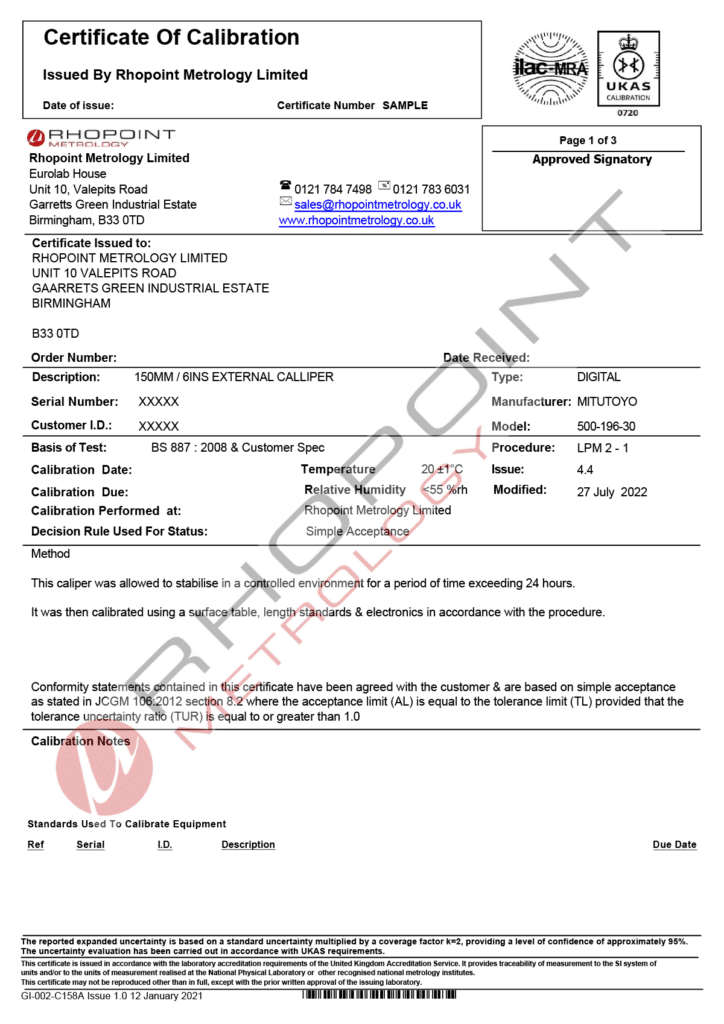British Standard Reference : BS 887 : 2008
1. Select the caliper that best suits your requirement. Ensure that the type, measuring range, graduations and other specifications of the caliper are appropriate to your application.
2. Never apply excessive force to the slider or the locking screws, should you be unfortunate and drop a caliper gauge, do not use until the caliper has been re-calibrated/repaired by an appropriate repair agent.
3. Be careful not to damage the measuring jaws and always examine both the internal and external measuring jaws for damage prior to use.
4. After use, clean the caliper with a lint free paper or cloth.
5. Check the slider movements for smoothness of travel. There should be no free play or intermittent restriction of movement. Report all non conformances to an appropriate authority.
6. When taking external measurements, position the workpiece as deep inside the measuring jaws as possible.
7. When taking internal measurements, position the measuring jaws as deep inside the workpiece as possible.
8. Avoid parallax errors by reading the scale directly from the front and squarely on.
9. Care should be taken with the measurement of small diameter holes, as these are somewhat smaller than the actual diameter indicated (see appendix 1).
10. When storing calipers for long periods of time, or when it needs oil, use a lint free paper or cloth dampened with a rust preventative oil and lightly wipe each section, ensure that the oil is spread evenly over the surfaces.
11. Always leave the measuring faces separated and when not in use, always place caliper in its case.
12. Never leave or store the caliper for long periods of time in a high humidity environment.
13. Never use a caliper that has not been calibrated, if in doubt consult an appropriate authority.
Vernier Calipers BS 887 : 2008
This standard covers vernier gauges with external and internal contact faces from 0 – 48″/0 -1000mm. Metric calipers measure lengths up to a maximum of 1000mm using a main scale and vernier scale graduated to read to 0.02mm. Imperial calipers measure lengths up to a maximum of 48″ using a main scale and vernier scale graduated to read to 0.001″. It may be uneconomical for any company or institution to invest in equipment to the level required in order to calibrate vernier calipers fully in accordance with the standard.
It is highly recommended that an appropriate authority such as a UKAS approved laboratory carries out a full calibration on vernier calipers at least once a year. In between UKAS calibrations at a frequency based on usage vernier gauges should be calibrated in-house. A typical in-house calibration would include a written procedure and an associated calibration record sheet which would contain as a minimum the following listed information:
(a) Serial number
(b) Location
(c) Procedure number
(d) The flatness of external measuring jaws
(e) The parallelism of external measuring jaws
(f) The parallelism of internal measuring jaws
(g) Linearity of the measuring scale
(h) Results
(i) Measurement uncertainty
(j) Sentence if appropriate
(k) Date and calibrators signature
(l) Traceability to National Standards
It is necessary that any person carrying out such calibration work should have received appropriate training and have shown the ability to be confident via a suitable training authority. Training records should be held and maintained.


